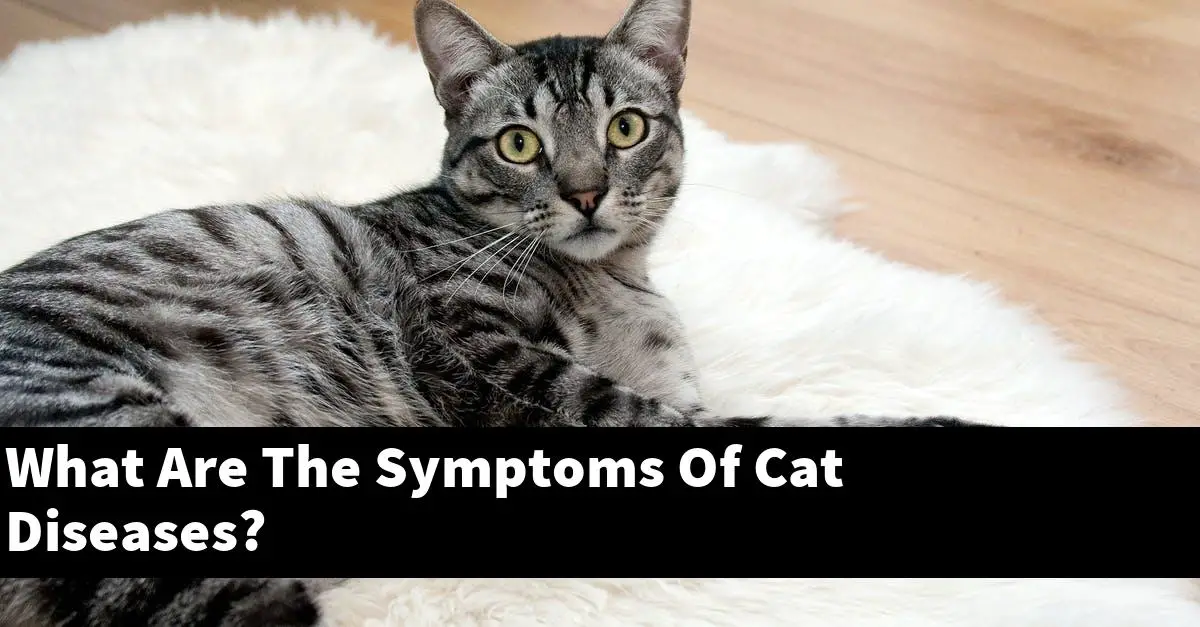There are a variety of diseases that can affect cats. Some of the more common symptoms include vomiting, diarrhea, weight loss, and lethargy.
More serious symptoms can include seizures, difficulty breathing, and jaundice. If you notice any of these symptoms in your cat, it is important to take them to the vet for a check-up.
How do I know if my cat has diseases?
Certain diseases can be detected by a veterinarian. Others can be detected by a veterinary health specialist.
Some diseases can be detected by both methods. Some diseases can only be detected by a veterinarian.
In general, there are a few ways to detect a disease in a cat. A veterinarian can take a complete medical history and perform a physical examination.
They may also do blood tests and urine tests. A veterinary health specialist may do a more detailed examination and may also do blood tests and urine tests.
Some diseases can be detected by a combination of methods. For example, a veterinarian may do a physical examination and may also do blood tests and urine tests to look for a specific type of cancer.
A veterinary health specialist may do a more detailed examination and may also do blood tests and urine tests to look for a specific type of cancer.
What are the most common health problems in cats?
The most common health problems in cats are obesity, diabetes, heart disease, and cancer.
What are Covid symptoms in cats?
Covid is a viral disease that affects cats. It is a highly contagious disease, and cats are the primary carriers.
The disease is characterized by fever, body aches, and a discharge from the nose and eyes. Affected cats usually become sick within two to four weeks after exposure and can die from the disease if not treated.
There is no vaccine or cure for Covid, and prevention is the best way to protect your cat.
What do cats eyes look like when they are sick?
When a cat is sick, their eyes may appear cloudy or watery. Additionally, the whites of their eyes may look yellow or green.
How do I know if my cat has a bacterial infection?
If your cat has a persistent discharge from the nose and eyes, has lost weight or become lethargic, has a fever over 102 degrees Fahrenheit, or has a persistent sour smell to their breath, they likely have a bacterial infection. Treatment typically includes antibiotics.
When do cats start having health problems?
Health problems in cats can start at any time and can range from minor to life-threatening. Some common health problems in cats include:
-Urinary tract infections (UTIs)
-Cancer
-Heart disease
-Diabetes
-Obesity
-Airway problems, including asthma
-Bladder problems, including urinary tract infections and interstitial cystitis
-Hepatitis
– OCD (obsessive-compulsive disorder)
-Feline leukemia
-Leukemia
-Lymphoma
-Behçet’s disease
-Strep throat
-Viral infections, such as feline leukemia and calici virus
What virus kills cats?
There are many viruses that can kill cats. However, the most common virus that kills cats is feline leukemia virus (FeLV). FeLV is a virus that attacks the cells of the cat’s immune system.
Over time, this can lead to the cat developing leukemia.
How can you tell if cat has a fever?
A fever is a body temperature that is above the normal range. A cat with a fever will be restless, have a dry mouth, and be more active than usual.
A fever can be caused by a number of things, including a viral infection, a bacterial infection, a cold, or a wound. There is no specific test that can be done to determine if a cat has a fever, but a veterinarian can make a diagnosis based on the symptoms.
If a cat has a fever, he or she should be treated with antibiotics and/or antiviral medication.
How long does Covid last in cats?
Covid is a long-acting feline leukemia vaccine that is typically effective for three years. After that, cats may need a booster vaccine.
Does my cat have cat flu?
Cat flu is a term used to describe a respiratory infection that is most commonly seen in cats. The virus is spread through contact with respiratory secretions, such as saliva, mucus, or blood, from an infected cat.
Symptoms of cat flu include coughing, sneezing, and runny nose. In some cases, the cat may also develop a fever.
Treatment for cat flu typically involves antibiotics.
Conclusion
The symptoms of cat diseases can vary depending on the disease. Some common symptoms include vomiting, diarrhea, weight loss, and lethargy.
If you notice any of these symptoms in your cat, it is important to take them to the vet for a check-up.

